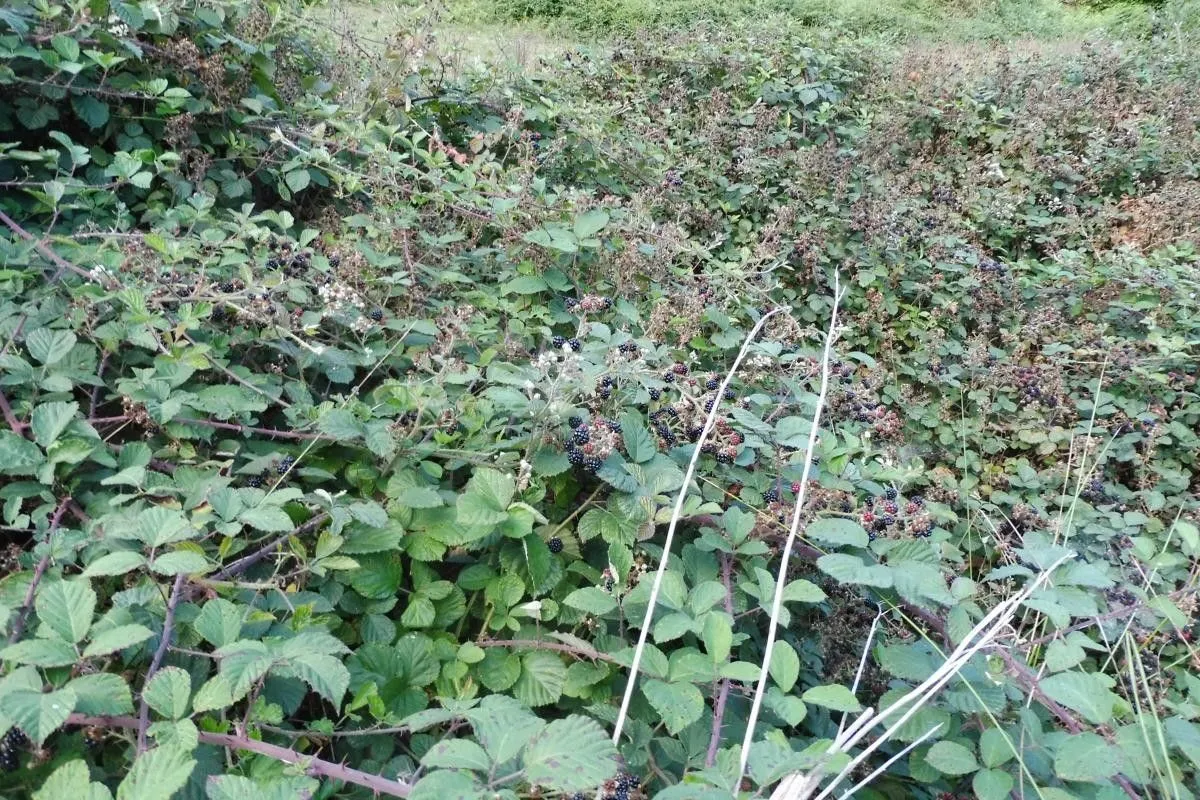
Author: Weihe
Bibliography: Comp. Fl. German. 1: 684 (1825)
Year: 1825
Status: accepted
Rank: species
Genus: Rubus
Vegetable: False
Observations: Europe
The European blackberry, scientifically known as Rubus vestitus, is a member of the Rosaceae family, renowned for its robust growth and rich clusters of dark, flavorful berries. This species was first formally described by the botanist Carl Ernst August Weihe in his pioneering work “Compendium Florae Germanicae,” published in 1825, marking it as a plant of significant botanical interest within German and broader European flora.
Native to the diverse habitats of Europe, the European blackberry thrives in a variety of environments, from forest edges to hedgerows and abandoned fields. Its ability to adapt to different conditions is one of the key reasons for its widespread presence across the continent.
The plant is characterized by its sprawling, often thorny stems, which can form dense thickets that are both a haven for wildlife and a bane for farmers due to their vigorous spreading nature. The leaves of Rubus vestitus are typically composed of three to five leaflets, each with a serrated edge and a slightly downy surface, contributing to the plant’s distinctive appearance.
During the flowering season, the European blackberry bursts into a display of delicate white to pinkish blossoms, which not only provide a source of nectar for bees and other pollinators but also signal the upcoming bounty of fruit. By late summer to early autumn, these flowers mature into clusters of black, juicy berries. These berries have been a food source for humans and animals alike for centuries, appreciated for their sweet and slightly tart flavor.
In addition to its ecological and culinary significance, the European blackberry holds a place in traditional medicine. The leaves, in particular, have been used in herbal remedies for their astringent properties, often employed in treating minor inflammations and digestive issues.
Despite its many positive attributes, Rubus vestitus can pose challenges as an invasive species in some non-native regions, where its aggressive growth can outcompete local flora. Effective management and control measures are essential to balance the benefits and drawbacks of this prolific berry-producing plant.
In summary, the European blackberry remains an integral part of Europe’s natural landscape, offering both beauty and practical uses to those who encounter it. From its resilience in various habitats to its role in ecosystems and human traditions, Rubus vestitus exemplifies the enduring connection between nature and culture.
Deu: bekleidete brombeere, samt-brombeere
Eng: european blackberry, soft-haired bramble
Dan: rundbladet brombær
Fra: ronce revêtue
Swe: rundbladsbjörnbär
Nld: fraaie kambraam
En: European blackberry, Soft-haired Bramble
Cs: Ostružiník hustochlupý
Da: Rundbladet brombær
Nl: Fraaie kambraam
Fi: Pyörövatukka
Fr: Ronce revêtue
De: Samt-Brombeere, Bekleidete Brombeere, Samtige Brombeere
It: Rovo rivestito, Rovo vestito
Sv: Rundbladsbjörnbär
Taken Oct 23, 2018 by Tela Botanica − Lydie Dufeu (cc-by-sa)
Taken Aug 14, 2022 by Nina Zenhäusern (cc-by-sa)
Taken Jul 28, 2018 by Tela Botanica − Lydie Dufeu (cc-by-sa)
Taken Oct 11, 2018 by Tela Botanica − Lydie Dufeu (cc-by-sa)
Taken Jul 19, 2022 by astrobio . exe (cc-by-sa)
Taken Jul 19, 2022 by astrobio . exe (cc-by-sa)
Taken Nov 13, 2022 by Milos Bajic (cc-by-sa)
Taken Aug 7, 2021 by Yannick Rideau (cc-by-sa)
Taken Jan 6, 2022 by Romke Brüntjen (cc-by-sa)
Taken Dec 6, 2022 by Jeanine Vialatte (cc-by-sa)
Taken Jun 16, 2018 by Tela Botanica − Lydie DUFEU (cc-by-sa)
Taken Sep 24, 2016 by Tela Botanica − Lydie DUFEU (cc-by-sa)
Taken Sep 24, 2016 by Tela Botanica − Lydie DUFEU (cc-by-sa)
Taken Sep 24, 2016 by Tela Botanica − Lydie DUFEU (cc-by-sa)
Taken Nov 27, 2022 by Edmondo Minisci (cc-by-sa)
Taken Sep 5, 2019 by Tela Botanica − Lydie Dufeu (cc-by-sa)
Taken Oct 16, 2018 by Tela Botanica − Lydie Dufeu (cc-by-sa)
Taken Aug 5, 2015 by Tela Botanica − David MERCIER (cc-by-sa)
Taken Aug 5, 2015 by Tela Botanica − David MERCIER (cc-by-sa)
Taken Dec 4, 2018 by Tela Botanica − Lydie Dufeu (cc-by-sa)
Taken Oct 11, 2018 by Tela Botanica − Lydie Dufeu (cc-by-sa)
Taken Oct 11, 2018 by Tela Botanica − Lydie Dufeu (cc-by-sa)
Taken Oct 11, 2018 by Tela Botanica − Lydie Dufeu (cc-by-sa)
Taken Oct 11, 2018 by Tela Botanica − Lydie Dufeu (cc-by-sa)
Taken Jul 19, 2022 by Torben Lynge Hansen (cc-by-sa)
Taken Oct 3, 2017 by Tela Botanica − Lydie DUFEU (cc-by-sa)
Taken Sep 24, 2016 by Tela Botanica − Lydie DUFEU (cc-by-sa)
Taken Sep 24, 2016 by Tela Botanica − Lydie DUFEU (cc-by-sa)
Taken Sep 24, 2016 by Tela Botanica − Lydie DUFEU (cc-by-sa)
Taken Sep 24, 2016 by Tela Botanica − Lydie DUFEU (cc-by-sa)
© copyright of the Board of Trustees of the Royal Botanic Gardens, Kew.
© copyright of the Board of Trustees of the Royal Botanic Gardens, Kew.
© copyright of the Board of Trustees of the Royal Botanic Gardens, Kew.
Growth habit: Subshrub
Ph maximum: 7.5
Ph minimum: 7.0
Light: 6
Atmospheric humidity: 6
Soil nutriments: 6
Family: Myrtaceae Author: (F.Muell.) K.D.Hill & L.A.S.Johnson Bibliography: Telopea 6: 402 (1995) Year: 1995 Status:…
Family: Rubiaceae Author: Pierre ex A.Froehner Bibliography: Notizbl. Bot. Gart. Berlin-Dahlem 1: 237 (1897) Year:…
Family: Sapindaceae Author: Koidz. Bibliography: J. Coll. Sci. Imp. Univ. Tokyo 32(1): 38 (1911) Year:…
Family: Asteraceae Author: A.Gray Bibliography: Pacif. Railr. Rep.: 107 (1857) Year: 1857 Status: accepted Rank:…
Family: Fabaceae Author: Medik. Bibliography: Vorles. Churpfälz. Phys.-Ökon. Ges. 2: 398 (1787) Year: 1787 Status:…
Family: Aspleniaceae Author: (Cav.) Alston Bibliography: Bull. Misc. Inform. Kew 1932: 309 (1932) Year: 1932…